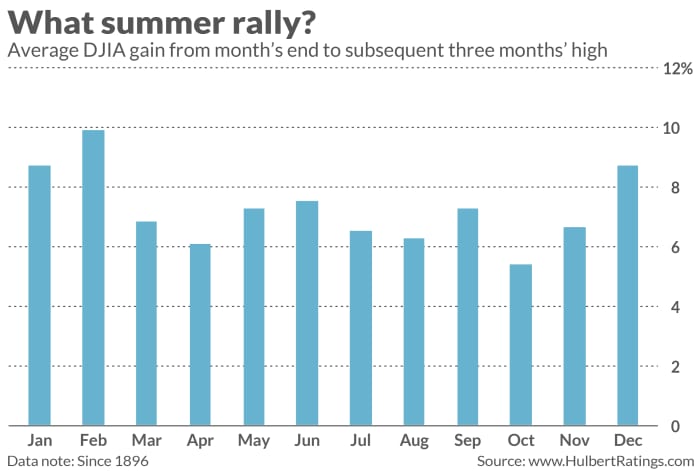This post was originally published on this site
Will a summer rally rescue the stock market from its relentless decline?
Some beleaguered bulls are shifting their hopes to seasonal strength during the summer months, since nothing else appears able to stanch the bleeding. The S&P 500
SPX,
has fallen 16% just since late March, while the Nasdaq
COMP,
has fallen 22%. Both declines are unusually severe for such a short period of time.
My research produces both good and bad news about a possible summer rally. The good news is that, based on historical averages alone, the stock market is likely to be 7.3% higher than where it stands today at some point this summer. In terms of the Dow Jones Industrial Average
DJIA,
that’s a gain of nearly 2,300 points.
The bad news is that there’s nothing special about this potential. Similar potentials, or greater, exist for other months of the calendar as well.

Precisely defining the summer rally poses a special challenge to researchers, since most who refer to the rally fail to say what exactly it entails. It can’t be just that the stock market will rally at some point during the summer, since it certainly will —sooner or later. It also will certainly decline at some point as well.
To ensure I had captured the greatest possible rally potential for the summer, I measured the stock market’s gain from the end of May to its highest level during the three-month period from June 1 to Aug. 31. This gain is hypothetical, of course, since only in retrospect will we know when that highest level has been hit. But it’s hard to imagine that, when using any other definition, the summer rally could be any bigger.
I applied my definition to the Dow Jones Industrial Average back to its creation in 1896. On average, the summer rally as so defined measured 7.3%. That’s how much the market will rally from the end of May to its highest level during the coming months of June, July and August — assuming this summer is “average.”
While such a rally would be very welcome, it needs to be put in context. The accompanying chart does that by reporting the average rally potential for all months of the calendar when measured in the same way. That is, for January, I measured the gain from the end of the month to its highest level in the subsequent February, March and April. For February, I measured the gain from its end to its highest level in the subsequent March, April and May. I did the same for all other months as well.
The average rally potential across all months is 7.3%, which is the same as it is for May individually. Four other months have a greater potential (January, February, June and December), though the differences between those months and the others is not significant at the 95% confidence level that statisticians often use when determining if a pattern is genuine.
From a seasonal perspective, in other words, the stock market’s rally potential is the same throughout the calendar.
The bottom line? The market will undoubtedly rally at some point this summer. But there’s no seasonally based justification for expecting a stronger such rally this summer than at any other time of the year. That, in turn, means you shouldn’t change your current investment posture just because summer is about to begin.
The bull market will need something strong than a summer rally to keep it alive.
Mark Hulbert is a regular contributor to MarketWatch. His Hulbert Ratings tracks investment newsletters that pay a flat fee to be audited. He can be reached at mark@hulbertratings.com.

